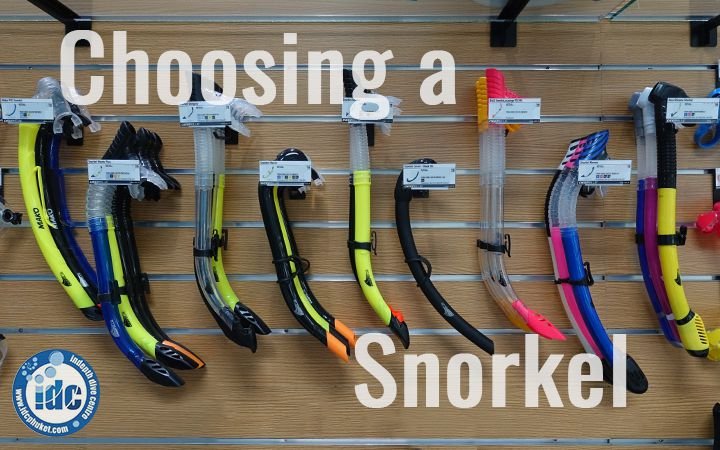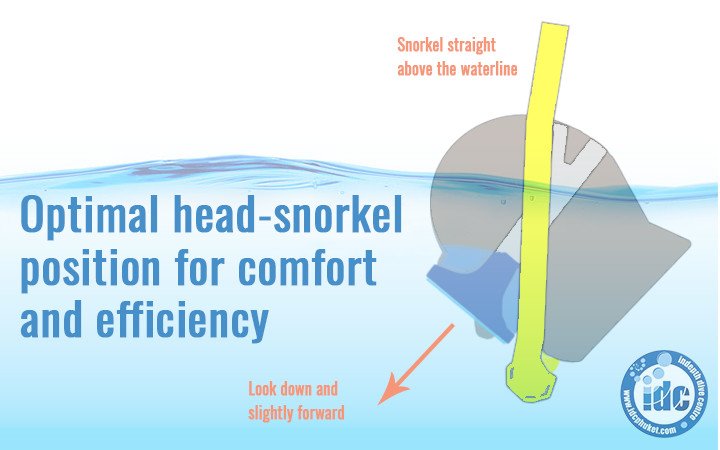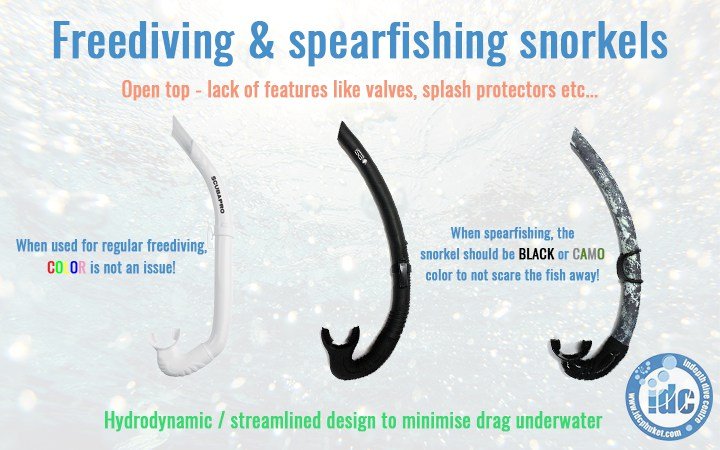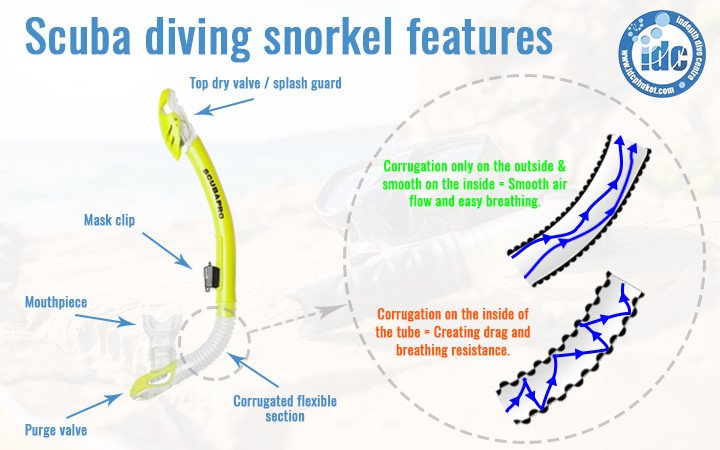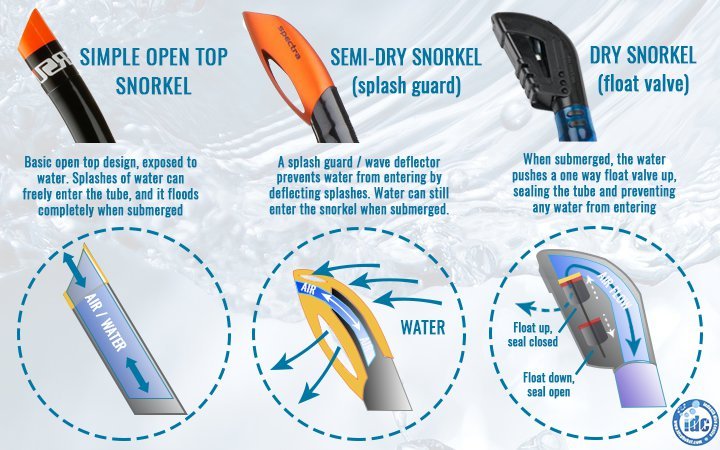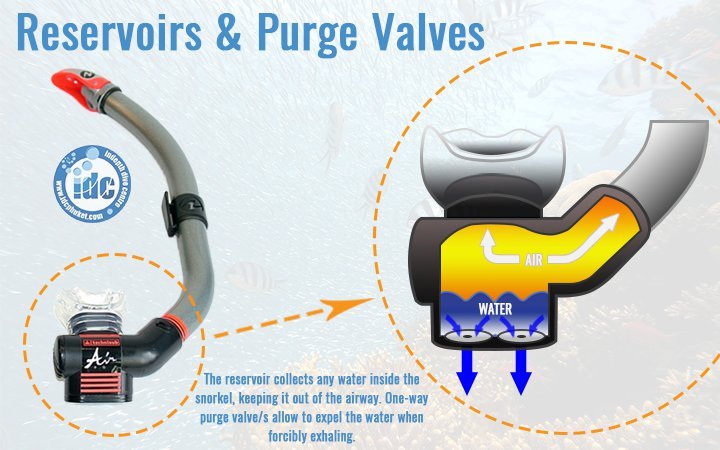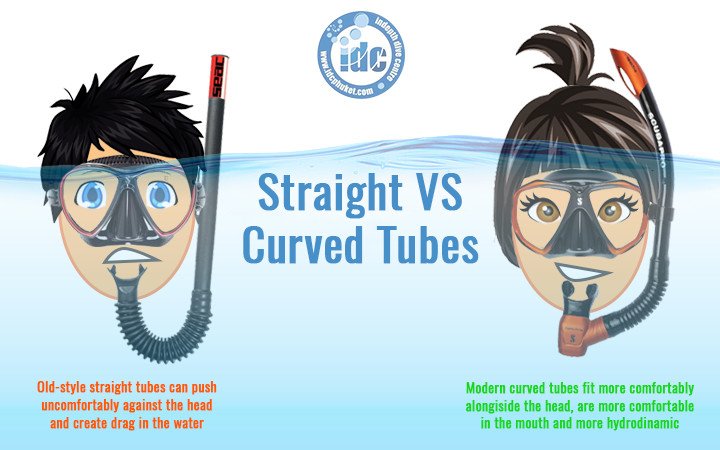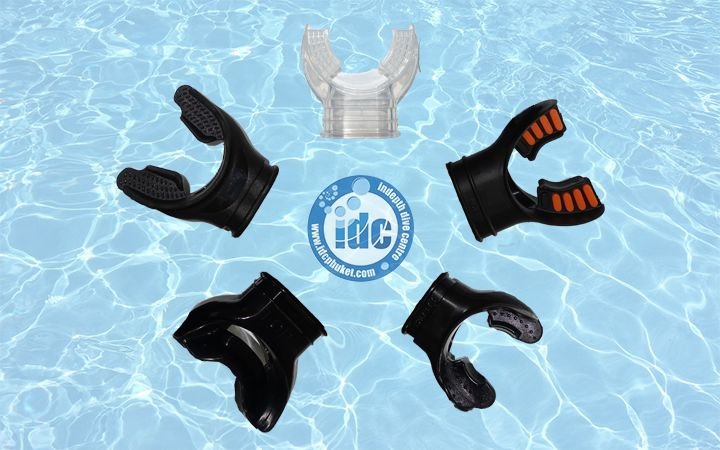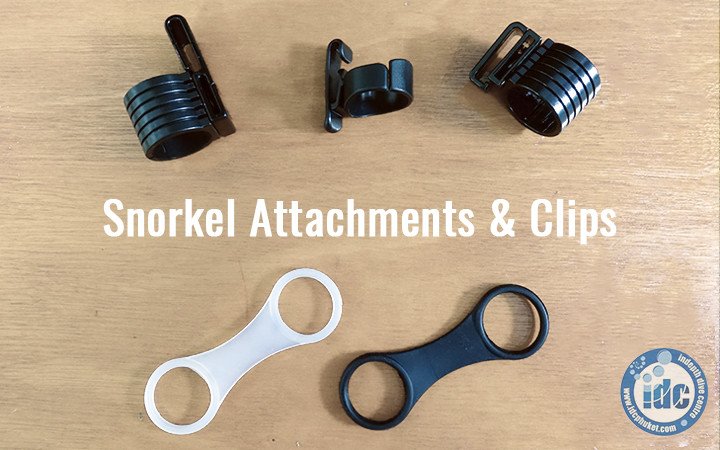How to choose a Snorkel
Snorkels, mask, and fins, are what we consider personal diving equipment. They are among the first items snorkellers and new divers purchase. Choosing a snorkel may sound like a straight forward endeavour, however, not all snorkels are equal in features and purpose!
Traditionally, a snorkel is a J-shaped hollow tube with a curved section at the bottom which connects to a mouthpiece. The purpose is to allow you to breathe on the surface without lifting your head from the water.
The humble snorkel dates back to 3000BC and started out as a hollowed-out reed or bamboo stem. As time passed, it has now evolved into a modern plastic design with multiple features, including full face mask options. Snorkels vary in design and quality. Choosing the right snorkel for you will depend on what type of watersports you plan to do. Is it going to be purely snorkelling, or are you spear-fishing, free diving, or scuba diving?
Comfort and Fit when choosing a snorkel
Fit and comfort are the most important elements of choosing your snorkel. You should position the snorkel on your mask at a height that lets it sit in your mouth without tension. This will avoid putting uncomfortable pressure on your jaw, or allow water to enter via the mouthpiece.
When comfortably in your mouth, looking down and slightly forward, the tip of your snorkel should be above the crown of your head in a vertical position. Remember that for the snorkel to work, the top of it must remain out of the water. Despite this, you should avoid an excessively long snorkel. All it will do is create a dead-air space and make breathing less efficient.
Your snorkel should have a diameter wide enough to allow you to breathe comfortably but still be narrow enough for you to easily expel water from the tube. It is important to breathe slowly and deeply and to exhale fully. This will allow you to exchange the air in your snorkel tube with each breath.
A snorkel is designed to be worn on your left-hand side and attach to your mask strap. For this reason, it is common to purchase masks and snorkels together. If you are interested in learning about the different types of masks available, click here.
Freediving and Spear-fishing Snorkels
Freediving is now a popular sport and as such, companies develop specialised equipment specifically for this endeavour. This includes masks, fins and snorkels
Freedivers only use their snorkels to breathe face down at the surface before their dives. The snorkel remains out of the diver’s mouth during the dive, keeping the airway easily accessible to assistants if needed.
A freediving snorkel is a simple, basic J-shaped design with a wider tube providing maximum inhalation and low breathing resistance. The simple, classic design is streamlined to minimize drag in the water.
When choosing a snorkel, consider that freediving snorkels typically do not include features such as a splash guard or reservoir. This means the top of the snorkel is usually open and water may enter easily. If this occurs, the diver will need to forcefully exhale to clear the water out the top of the snorkel. Consequently, this design is more suitable for divers and snorkelers with more confidence in the water and good airway control.
The bore (length and diameter of the tube) affect the breathing resistance. For freediving, a snorkel with a larger diameter and a tube with a length of less than 35cm is ideal. Longer tubes increase the breathing resistance and create a larger dead air space.
A spear-fishing snorkel is similar to a freediving snorkel in its simplicity. The difference is that it is normally black or camo to avoid scaring away the fish with bright colours.
Choosing Freediving or Spear-fishing Snorkel for Snorkeling or Diving
The classic and simple design of freediving and spear-fishing snorkels is suitable for use when snorkelling or scuba diving. They are is generally a cheaper, more affordable option for many divers choosing their snorkel.
The main difference between a classic design snorkel used for snorkelling versus freediving/spearfishing is the tip of the snorkel. The one used by snorkellers has a bright colour to make it easily visible to other snorkelers/divers and boats.
A classic style of snorkel designed purely for snorkelling may also be slightly longer and thinner than its freediving counterpart. One disadvantage for snorkelers and scuba divers of this model is the lack of features, including the open-top. This makes the snorkel less comfortable, particularly for long periods of time and for those less confident in the water.
Scuba Diving Snorkels
Scuba diving snorkels come in a range of colours and materials. Traditionally, snorkels used for both snorkelling and diving have bright colours at the top to be easily visible from boats.
Why does a scuba diver need to choose a snorkel? It may seem odd for a scuba diver to carry a snorkel, however, divers use their snorkel on the surface to preserve the air in their tank. Scuba divers learn on their Open Water Diver Course to conserve their air by switching between their scuba regulator and snorkel on the surface. This may be necessary if the diver surfaces a long distance from their exit point and/or in wavey conditions. Combining this with limited air reserves left in their tank will make it impractical for them to breathe from their scuba regulator. A snorkel can provide airway protection for the diver in these conditions.
As divers don't use their snorkel during the dive, a popular feature of scuba diving snorkels is a flexible, corrugated silicone section between the mouthpiece and the tube. This allows the mouthpiece to position comfortably in the diver’s mouth when in use but also for it to fall away from the diver’s face when not in use. It is important, however, that the corrugation should only be on the outside of the tube. The inside should remain smooth to avoid breathing resistance or turbulence inside the tube.
Choosing a snorkel with Splash Guards and Dry Top Valves
While the classic simple snorkel is open at the top and exposed to water, the semi-dry and dry snorkel models come with added features which improve overall comfort and safety, particularly for new snorkelers. It is important to consider these features when choosing a snorkel.
A ‘semi-dry’ snorkel contains a splash guard or wave deflector which can be found at the very top of the snorkel and is ideal for wavey or choppy conditions. The splash guard prevents water from entering the snorkel from above by capping the snorkel tube and deflecting water splashes away. If you submerge under the surface though, water can enter the snorkel which you will then need to clear by forcible exhalation.
A ‘dry’ snorkel contains a one-way dry top valve which will shut when the snorkel is submerged under the surface of the water, stopping the water from entering the tube from above. This feature keeps the snorkel filled with air, even if you swim or duck under the surface of the water. The valve reopens once you resurface, removing the need for you to clear your snorkel. This design is ideal for snorkellers who are less confident in the water or who lack airway control. One downside of this feature is that this type of snorkel is a little bit bulkier than other models and can be slightly more buoyant in the water.
Choosing a snorkel with reservoirs and purge valves
When choosing a snorkel, note that many snorkels contain a reservoir or chamber below the mouthpiece which catches any water inside the snorkel and drains it away from your mouth. This feature protects your airway, even when there is water in the snorkel. It is common for these designs to also contain a one-way purge valve made of soft silicone. The valve will open when you forcibly exhale, allowing you to easily expel the water from the reservoir. With a classic snorkel design, instead, you would have to force the water back up the tube and out the top.
Flexible or rigid snorkel tubes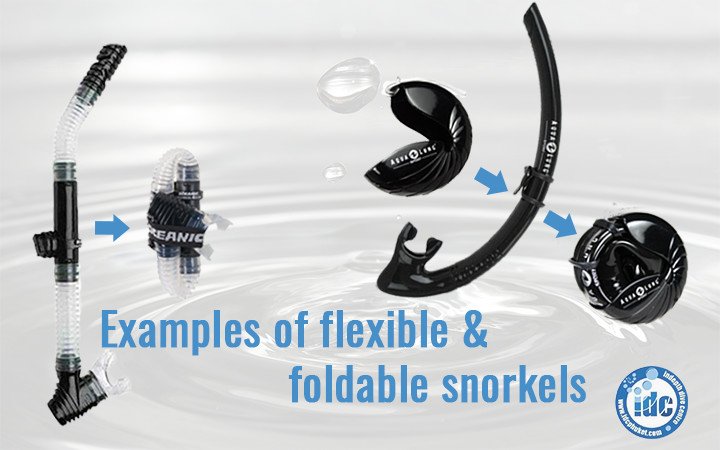
Snorkel tubes fall into two categories: hard and rigid or flexible. A hard, rigid tube is not always the best option for two reasons: it is prone to damage if accidentally stepped on, and can create drag in the water. These models are generally less expensive though. A more flexible material, in rigid form but which can easily bend and flex, is desirable as it's more durable and long-lasting. Keep this in mind when choosing and buying your snorkel.
In addition, whilst many snorkels are rigid, for scuba divers who only use their snorkels on the surface it is now popular to use a flexible snorkel. This type of snorkel can be unclipped from the mask and either folded down or even rolled up and stored in the diver’s pockets during the dive. Due to the flexible nature of these snorkels, they are durable and shock-resistant. These models are also ideal for traveling as they are very compact and take up very little space.
Straight or curved snorkel tubes
Snorkel tubes were traditionally straight, placing the snorkel into an often comfortable position against the snorkeller’s head when in the water. A straight snorkel is less ergo dynamic and can create drag in the water. It is possible for this style of snorkel to even wobble against the diver’s head when not in use on a scuba dive. A curved tube has become more popular as it fits more comfortably around and alongside the user's head and is more ergonomic & comfortable in the mouth.
Snorkel Mouthpieces
A good mouthpiece should be made of 100% silicone so it is soft, flexible and comfortable. Silicone is also hygienic and is unlikely to rub or cause irritation, even after prolonged use. Mouthpieces generally come in different sizes and on some models of snorkel are detachable and replaceable.
A smaller mouthpiece is ideal for women and children whereas some snorkellers find a larger mouthpiece to be more comfortable. Some snorkels allow you to attach your own mouthpiece, similar to a scuba regulator. This gives the option of selecting a mouthpiece that can be personalised for you and helps to reduce jaw fatigue. This is an important factor to consider when choosing a snorkel.
Choosing a snorkel - Materials
When choosing a snorkel, look for one made from high-quality silicone materials. Silicone is an ideal material for snorkelling equipment, being more resistant to ultraviolet rays and chlorine than other materials. Silicone is also soft and flexible making the snorkel more comfortable to use. Snorkels of lower quality, made with cheaper materials such as PVC or silita are more rigid, less comfortable and may warp over time or when exposed to heat. It is also common for snorkels of lower quality to discolour over time.
In addition, when used in mouthpieces, cheaper materials such as silita can be uncomfortable and rub when used for prolonged periods of time. Purchasing lower quality equipment generally means the equipment is less durable and less likely to withstand the test of time, meaning you will need to replace it more often. We recommend you invest in quality equipment from the start, which will be more comfortable to use and will last longer.
Snorkel Attachments
All snorkels need to attach to a mask. The types of attachments are as varied as the snorkels themselves. A popular option is a rigid plastic clip on the snorkel which simply opens to allow the mask strap to fit inside. This option provides for faster and easier attachment and detachment. Clips are also available which simply slide on to the mask. Some clips also limit the need to adjust the positioning of the snorkel at each use. You can simply attach your snorkel to your mask and it will be in the same position it was last time you used it.
A silicone 8-shaped snorkel retainer is another popular and inexpensive option. This option fits around the snorkel tube and attaches to the mask strap. Being silicone it is often more comfortable against your head, but it slides easily so you may have to adjust it before each use.
Full Face Mask Snorkels
Full face masks are the latest innovation in snorkelling equipment. They are worn over your face with the snorkel attached to the mask, above your forehead. This design means you don't wear anything in your mouth and can breathe through both your mouth and nose. This is ideal for those who struggle biting down on a mouthpiece, as well as beginners. People can only wear These masks on the surface as the snorkeller does not have access to their nose and cannot equalise if they try to dive down.
When choosing your snorkel you must know that full-face mask snorkels are NOT compatible with scuba diving. They are a solution suitable only for actual snorkelling on the surface.
However, disadvantages and potential dangers of this design come with cheaper models. As they are not well designed or tested, unless the user adequately exhales, carbon dioxide can accumulate inside the mask. In particular circumstances, this can lead to serious safety issues. For this reason, it is recommended you only use high-quality snorkelling equipment or take a course and learn to snorkel using traditional equipment. This VIDEO explains the issue with poorly designed full-face masks, and how to avoid it, extremely well.
With most products in this day and age, the choices and variety can be overwhelming. We encourage you to come to try the equipment in person and find the most comfortable for you. Alternatively, if you are unable to make it to us, we are more than happy to answer any question or to provide some recommendations for you. For more information, please contact us here.
More posts about diving equipment:
- Choosing Dive Equipment
- Choosing a Scuba Diving Mask
- All about snorkels
- Choosing the right fins
- Scuba Cylinders & Valves
- Buoyancy Control Devices (BCDs)
- How to choose a Scuba Regulator
- Breathing Gas Monitoring Devices
- Depth Monitoring Devices
- Scuba Diving Weights & Quick Release Weight Systems
- Choosing a wetsuit for Scuba Diving
- Audible Signaling Devices for Scuba Diving
- Choosing a Scuba Diving Compass



